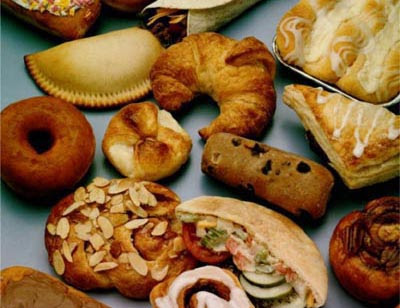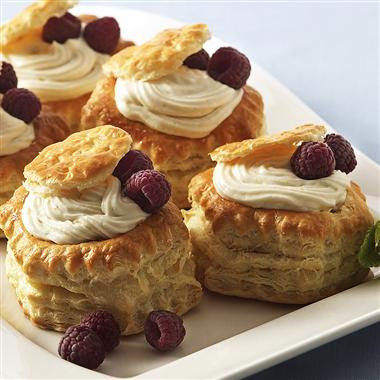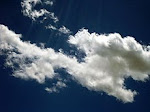[http://www.reference.com/browse/pastry]
pastry,
general
name
for
baked
articles
of
food
made
of
paste
or
having
paste
as
a
necessary
ingredient.
The
name
is
also
used
for
the
paste
itself.
The
essential
elements
of
paste
are
flour,
liquid
(usually
milk
or
water,
sometimes
beaten
egg),
and
shortening.
The
making
of
pastry
was
known
to
the
ancient
Greeks
and
Romans,
but
its
modern
development
in
the
Western
world
dates
from
the
late
18th
cent.
Pastry
is
classed
according
to
the
amount
of
shortening
used
and
the
method
of
blending
it
with
the
flour
as
plain,
flaky,
and
puff
pastry.
Plain
pastry
is
used
to
cover
meat
or
fruit
pies;
flaky
pastry,
which
requires
more
shortening
than
plain,
is
used
in
strudels
and
the
Turkish
baklava.
Puff
pastry
is
used
in
the
making
of
cream
puffs
and
éclairs.
The
Columbia
Electronic
Encyclopedia
Copyright
© 2004.
Licensed from Columbia University Press
Licensed from Columbia University Press
|
(Photo by flickr.com) [http://www.thefreedictionary.com/pastry] pastry - any of various baked foods made of dough or batter
flour - fine powdery
foodstuff obtained by grinding and sifting the meal of a cereal grain
baked goods -
foods (like breads and cakes and pastries) that are cooked in an oven
frangipane
- pastry with a creamy almond-flavored filling
streusel
- pastry with a topping of streusel
tart - a
pastry cup with a filling of fruit or custard and no top crust
timbale case, timbale - small
pastry shell for creamy mixtures of minced foods
pie -
dish baked in pastry-lined pan often with a pastry top
French pastry -
sweet filled pastry made of especially puff paste
bouchee,
patty shell -
shell of puff paste
sausage roll -
sausage meat rolled and baked in pastry
toad-in-the-hole
- sausage baked in batter
vol-au-vent -
puff paste shell filled with a savory meat mixture usually with a sauce
strudel - thin sheet
of filled dough rolled and baked
baklava
- rich Middle Eastern cake made of thin layers of flaky pastry filled
with nuts and honey
profiterole - a
small hollow pastry that is typically filled with cream and covered with
chocolate
puff - a light inflated
pastry or puff shell
|
Based on WordNet 3.0, Farlex clipart collection. ©
2003-2008 Princeton University, Farlex Inc.
pastry
noun tart, Danish (pastry), pasty, tartlet high fat foods such as cakes and pastries see cakes and pastries
Types of pastry
choux pastry, filo pastry, flaky pastry, hot water pastry, pâte brisée, pâte feuilletée, pâte sucrée, puff pastry, rough puff pastry, shortcrust pastry, suet pastry
Collins Thesaurus of the English Language – Complete and Unabridged 2nd Edition. 2002 © HarperCollins Publishers 1995, 2002
Pastry is the name given to various kinds of baked goods
made from ingredients such as flour, butter, shortening,
baking powder or eggs.
Small cakes, tarts and other sweet baked goods are called
"pastries".
Pastry may also refer to the dough from which such baked goods are made. Pastry dough is rolled out thinly and used as a base for baked goods. Common pastry dishes include pies, tarts and quiches.
Pastry is distinguished from bread by having a higher fat content, which contributes to a flaky or crumbly texture. A good pastry is light and airy and fatty, but firm enough to support the weight of the filling. When making a shortcrust pastry, care must be taken to blend the fat and flour thoroughly before adding any liquid. This ensures that the flour granules are adequately coated with fat and less likely to develop gluten. On the other hand, overmixing results in long gluten strands that toughen the pastry. In other types of pastry, such as Danish pastry and croissants, the characteristic flaky texture is achieved by repeatedly rolling out a dough similar to that for yeast bread, spreading it with butter, and folding it to produce many thin layers of folds. Many pie recipes involve blind-baking the pastry before the filling is added. Pastry dough may be sweetened or perhaps unsweetened.
Shortcrust pastry Shortcrust, or short, pastry is the simplest and most common pastry. It is made with flour, fat, salt, and water. The process of making pastry includes mixing of the fat and flour, adding water, and rolling out the paste. It is cooked at 180°C and the result is a soft, tender pastry. A related type is the sweetened sweetcrust pastry.
Pastry may also refer to the dough from which such baked goods are made. Pastry dough is rolled out thinly and used as a base for baked goods. Common pastry dishes include pies, tarts and quiches.
Pastry is distinguished from bread by having a higher fat content, which contributes to a flaky or crumbly texture. A good pastry is light and airy and fatty, but firm enough to support the weight of the filling. When making a shortcrust pastry, care must be taken to blend the fat and flour thoroughly before adding any liquid. This ensures that the flour granules are adequately coated with fat and less likely to develop gluten. On the other hand, overmixing results in long gluten strands that toughen the pastry. In other types of pastry, such as Danish pastry and croissants, the characteristic flaky texture is achieved by repeatedly rolling out a dough similar to that for yeast bread, spreading it with butter, and folding it to produce many thin layers of folds. Many pie recipes involve blind-baking the pastry before the filling is added. Pastry dough may be sweetened or perhaps unsweetened.
Main types of pastry:
(Photos by howstuffswork.com, en.wikipedia.org, Ian Shortman)Shortcrust pastry Shortcrust, or short, pastry is the simplest and most common pastry. It is made with flour, fat, salt, and water. The process of making pastry includes mixing of the fat and flour, adding water, and rolling out the paste. It is cooked at 180°C and the result is a soft, tender pastry. A related type is the sweetened sweetcrust pastry.
Flaky (or rough puff) pastry Flaky pastry is a simple pastry that expands when cooked due to the number of layers. This is perfect if you are looking for a crisp, buttery pastry. The “puff” is obtained by beginning the baking process with a high temperature and lowering the temperature to finish.
Puff pastry Puff pastry has many layers that cause it to expand or “puff” when baked. Pastries are made using flour, butter, salt, and water. Pastry rises up due to the combination and reaction of the four ingredients and also from the air that gets between the layers. Puff pastries come out of the oven light, flaky, and tender.
Choux pastry Choux pastry is a very light pastry that is filled with cream. The pastry is filled with various flavors of cream and is often topped with chocolate. Choux pastries can also be filled with things like cheese, tuna, or chicken to be used as appetizers.
(Photos by en.wikipedia.org, bakingbites.com, flickr.com)
Pastries go back to the ancient Mediterranean almost paper-thin multi-layered baklava and filo. Medieval Europe took on pastry making after the Crusaders brought it back. French and Italian Renaissance chefs eventually perfected the Puff and Choux pastries, while 17th and 18th century chefs brought new recipes to the table. These new pastries included brioche, Napoleons, cream puffs, and éclairs. French chef Antonin Careme reportedly was the first to incorporate art in pastry making.
European traditions of pastry-making is often traced back to the short crust era flaky doughs that were in use throughout the Mediterranean in ancient times. These recipes were popularized in Western Europe by Crusaders returning home.
In the Mediterranean, the Romans, Greeks and Phoenicians all had filo-style pastries in their culinary traditions. There is also strong evidence that the ancient Egyptians produced pastry-like confections. It is very possible that Egyptians made and ate pastries. They had professional bakers that surely had the skills to do so, and they also had needed materials like flour oil and honey. In the plays of Aristophanes, in 5th century BC, there are mentions of sweetmeats including small pastries filled with fruit. The Romans used flour, oil and water to make pastries that were used to cover meats and fowls. They did this during baking to keep in the juices, but this was not meant to be eaten by people. A pastry that was meant to be eaten was a richer pastry that was made into small pastries and contained eggs or little birds. It was often served at banquets. Greeks and Roman both struggled in making a good pastry because of the fact that they both used oil in the cooking process and oil causes the pastry to lose its stiffness.
In medieval North Europe they were able to produce nice, stiff pastries because they cooked with lard and butter. There were some incomplete lists of ingredients found in medieval cookbooks, but no full, detailed versions. There were stiff, empty pastries called coffins or 'huff paste', that were eaten by servants only and included an egg yolk glaze to help make them more enjoyable to consume. Medieval pastries also included small tarts to add richness to the snack. It was not until about the Mid 16th century until actual pastry recipes showed up. These recipes were adopted and adapted over time in various European countries, resulting in the myriad of pastry traditions known to the region, from Portuguese "pastéis de nata" in the west to Russian "pirozhky" in the east. The use of chocolate in pastry-making in the West, so commonplace today, arose only after Spanish and Portuguese traders brought chocolate to Europe from the New World starting in the 1500s. Many culinary historians consider French pastry chef Antonin Carème (1784–1833) to have been the first great master of pastry making in modern times.
Pastry-making also has a strong tradition in many parts of Asia. Chinese pastry is made from rice, or different types of flour, with fruit, sweet bean paste or sesame-based fillings. Beginning in the 19th century, the British brought western-style pastry to the far east, though it would be the French influenced Maxim in the 1950s that made western pastry popular in Chinese-speaking regions starting with Hong Kong. Still, the term "Western Cake" (西餅) is used to differentiate between the automatically assumed Chinese pastry. Other Asian countries such as Korea have traditionally prepared pastry-confections such as tteok, hangwa, and yaksi with flour, rice, fruits, and regional specific ingredients to make unique type desserts. And Japan also has specialized pastry-confections better known as mochi and manju. Pastry-confection that originate in Asia are clearly distinct from those that originate in the West that are generally much sweeter.
Definitions of Terms:
(Photos by slamchowder.com, mccormick.com, flickr.com)Pastry A mixture of flour, fat, possibly egg and sugar, the fat usually dispersed as small solid globules coated with flour and the whole brought together with liquid prior to shaping and baking. There are many types of pastry.
Pastry bag or Piping bag An often cone shaped bag that is used to make an even stream of dough, frosting, or flavored substance, to form a structure, decorate a baked good, or fill a pastry with a custard, cream, jelly, or other filling.
Pastry board A square or oblong board preferably marble but usually wood on which pastry is rolled out.
Pastry brake Opposed and contra-rotating rollers with a variable gap through which pastry can be worked and reduced in thickness for commercial production. A very small version is used domestically for pasta production.
Pastry case An uncooked or blind baked pastry container used to hold savory or sweet mixtures.
Pastry cream Confectioner's custard. An egg and flour thickened custard made with sweetened milk flavored with vanilla. Used as a filling for flans, cakes, pastries, tarts, etc. The flour prevents the egg from curdling.
Pastry cutters Various metal or plastic outlines of shapes, e.g. circles fluted circles, diamonds, ginger bread men, etc. Sharpened on one edge and used to cut out corresponding shapes from biscuit, scone, pastry, or cakes mixtures.
Pastry blender A kitchen implement used to properly combine the fat and flour. Usually constructed of wire or plastic, with multiple wires or small blades connected to a handle.
Pastry chef
(Photo by blackberrycool.com, flickr.com, pillsbury.com, wilyeastblog.com, Palladian.com)
(Photos by http://en.wikipedia.org, Simon Lee Bakery)
More interesting information via :
http://www.pfisterconsulting.com/history.htm

































2 comments:
So... so... yummy!
http://assistedlivinglittlerockarkansas.com
Post a Comment